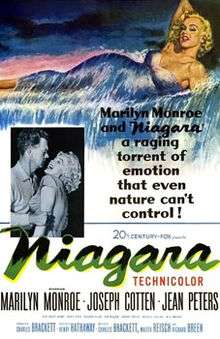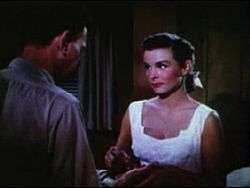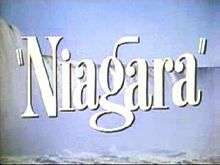Niagara (film)
| Niagara | |
|---|---|
 Theatrical release poster | |
| Directed by | Henry Hathaway |
| Produced by | Charles Brackett |
| Screenplay by |
Charles Brackett Richard L. Breen Walter Reisch |
| Starring |
Marilyn Monroe Joseph Cotten Jean Peters Max Showalter |
| Narrated by | Joseph Cotten |
| Music by | Sol Kaplan |
| Cinematography | Joseph MacDonald |
| Edited by | Barbara McLean |
| Distributed by | Twentieth Century-Fox |
Release dates |
|
Running time | 88 minutes |
| Country | United States |
| Language | English |
| Budget | US$ 1,670,000[1] |
| Box office | $2.35 million (US)[2] |
Niagara is an American 1953 film noir thriller film directed by Henry Hathaway, and starring Marilyn Monroe, Joseph Cotten, Jean Peters, and Max Showalter. It was one of Fox's biggest box office hits of the year.
Unlike other film noirs of the time, Niagara was filmed in "three-strip" Technicolor (one of the last films to be made at Fox in that format, as a few months later Fox began converting to CinemaScope, which had compatibility problems with "three-strip" but not with Eastmancolor).
Monroe was given first billing in Niagara which elevated her to star status. Her following two films of that year, Gentlemen Prefer Blondes, with Jane Russell, and How to Marry a Millionaire, with Betty Grable and Lauren Bacall, were even bigger successes.
Plot
Ray and Polly Cutler (Showalter and Peters), on a delayed honeymoon at Niagara Falls, find their reserved cabin occupied by George and Rose Loomis (Cotten and Monroe). Rose tells them that George is asleep at last, and has recently been discharged from an Army mental hospital after his war service in Korea. The Cutlers politely accept another, less desirable cabin, and so the two couples become acquainted.


George and Rose have a troubled marriage. She is younger and very attractive. He is jealous, depressed and irritable. While touring the falls the following day, Polly sees Rose passionately kissing another man, Patrick, her lover. That evening, the Cutlers witness George's rage. Rose joins an impromptu party and requests that a particular record be played. George storms out of their cabin and breaks the record, because he suspects the song has a secret meaning for Rose. Seeing George has cut his hand with the record, Polly visits his room to apply bandages to his injury. George confides that he was a sheep rancher whose luck turned for the worse after he fell in love and married Rose, whom he met when she was a barmaid.
What George does not know is that Rose and Patrick are planning to murder him. The next day, Rose lures George into following her to the dark tourist tunnel underneath the Falls. There Patrick is going to kill him. To let Rose know that George is dead, Patrick will request the Rainbow Tower Carillon play Rose's special song ("Kiss"; music by Lionel Newman, lyrics by Haven Gillespie, both uncredited). When she hears the tune being played on the carillon bells, Rose concludes George is dead.
In fact, it is George who has killed Patrick, thrown his body into the falls, and collected Patrick's shoes at the exit instead of his own. This leads the police to believe that George is the victim. The body is retrieved and the police bring Rose to identify George's body. When the cover is lifted from the face and she recognizes the dead man, she collapses and is admitted to hospital.
The motel manager moves the Cutlers' belongings to the Loomis's cabin. George comes to the cabin to kill Rose in revenge, but finds Polly there instead. She wakes and sees him before he runs away. She tells the police, who launch a dragnet.
During the Cutlers' second visit to the Falls, George finds Polly alone for a moment. Trying to escape, she slips, but he saves her from falling over the edge into the waterfall torrent. He explains to her that he killed Patrick in self-defense and pleadingly begs, "Please ... let me stay dead." Polly leaves without answering. Later that day, she tells the police detective that she believes George is alive. George has the carillon play "Kiss" again to panic Rose.
She flees the hospital, intending to return to the U.S. Finding George waiting at the border for her, she runs and tries to hide in the carillon bell tower. George catches her and strangles her beneath the bells, which remain silent. Remorsefully he says, "I loved you, Rose. You know that."
The Cutlers go fishing with friends in a launch on a section of the Niagara River above the Falls. When the launch moors in Chippawa, Ontario, for gasoline and other supplies, George steals the boat, with Polly still on board. The police set out in pursuit. The boat runs out of gas and drifts towards the Falls. As they near the edge, George scuttles the boat to slow it down and manages to get Polly onto a large rock before he goes over the Falls to his death. Polly is rescued from the rock by a United States Coast Guard Sikorsky H-19 Chickasaw helicopter.
Cast (in credits order)
- Marilyn Monroe as Rose Loomis
- Joseph Cotten as George Loomis
- Jean Peters as Polly Cutler
- Max Showalter as Ray Cutler (billed as Casey Adams)
- Denis O'Dea as Inspector Starkey
- Richard Allan as Patrick
- Don Wilson as Mr. Kettering
- Lurene Tuttle as Mrs. Kettering
- Russell Collins as Mr. Qua
- Will Wright as Boatman
Reception
Critical response
When the film was released, The New York Times praised the film, if not the acting. They wrote in January 1953, "Obviously ignoring the idea that there are Seven Wonders of the World, Twentieth Century-Fox has discovered two more and enhanced them with Technicolor in Niagara... For the producers are making full use of both the grandeur of the Falls and its adjacent areas as well as the grandeur that is Marilyn Monroe... Perhaps Miss Monroe is not the perfect actress at this point. But neither the director nor the gentlemen who handled the cameras appeared to be concerned with this. They have caught every possible curve both in the intimacy of the boudoir and in equally revealing tight dresses. And they have illustrated pretty concretely that she can be seductive - even when she walks. As has been noted, Niagara may not be the place to visit under these circumstances but the falls and Miss Monroe are something to see."[3]

Also in 1953, the staff at Variety wrote, "Niagara is a morbid, cliched expedition into lust and murder. The atmosphere throughout is strained and taxes the nerves with a feeling of impending disaster. Focal point of all this is Marilyn Monroe, who's vacationing at the Falls with hubby Joseph Cotten...The camera lingers on Monroe's sensuous lips, roves over her slip-clad figure and accurately etches the outlines of her derrière as she weaves down a street to a rendezvous with her lover. As a contrast to the beauty of the female form is another kind of nature's beauty — that of the Falls. The natural phenomena have been magnificently photographed on location."[4]
More recent critics have also hailed the film. In 2001, Robert Weston wrote, "Niagara is a good movie for noir fans who crave something a little different. Be warned, the film was shot in glorious Technicolor, not black and white, but still boasts an ample share of shadows and style...Undoubtedly, the best reason to see Niagara is just as trailer promised: for the scenery. There's some terrific location work that showcases the breathtaking aspects of the Falls before the city evolved into a tawdry Canadian answer to Atlantic City; and of course, there's a gal named Marilyn Monroe, burgeoning at her humble beginnings."[5]
Noir themes
A major theme is that of sex and its destructiveness.[6] Rose is a femme fatale, seductively dressed in tight clothes revealing her sensual figure. Her relationship (combining the sexual, hypocritical, and scornful) with George is contrasted with the more normal relationship of the Cutlers, which also has sexual elements hinted at by the film. Ray Cutler does not fail to notice the sexual charms of Rose, but the reaction of both Ray and Polly to their interactions with George and Rose demonstrate the conventionality of their attitudes.[7]
Legacy
In the weeks after Monroe's death in August 1962, Andy Warhol used a publicity photo from Niagara as the basis for his silkscreen painting Marilyn Diptych, showing multiple images of Monroe's face.
References
- ↑ Solomon, Aubrey. Twentieth Century Fox: A Corporate and Financial History (The Scarecrow Filmmakers Series). Lanham, Maryland: Scarecrow Press, 1989. ISBN 978-0-8108-4244-1. p248
- ↑ 'The Top Box Office Hits of 1953', Variety, January 13, 1954
- ↑ The New York Times. "Niagara Falls Vies With Marilyn Monroe," film review, January 22, 1953. Last accessed: December 27, 2007.
- ↑ Variety. Film review, 1953. Last accessed: February 2, 2008.
- ↑ Weston, Robert. Film Monthly, film review and analysis, August 24, 2001. Last accessed: June 27, 2010.
- ↑ Silver, Alain & Elizabeth Ward, Film Noir (1979). The Overlook Press: Woodstock, New York.
- ↑ Riese, Randall, The Unabridged Marilyn: Her Life from A to Z (1990). Bonanza Books: Modesto, California.
External links
| Wikiquote has quotations related to: Niagara (film) |
| Wikimedia Commons has media related to Niagara (film). |
- Niagara at the Internet Movie Database
- Niagara at AllMovie
- Niagara at the TCM Movie Database
- Niagara at Rotten Tomatoes
- Niagara film trailer on YouTube